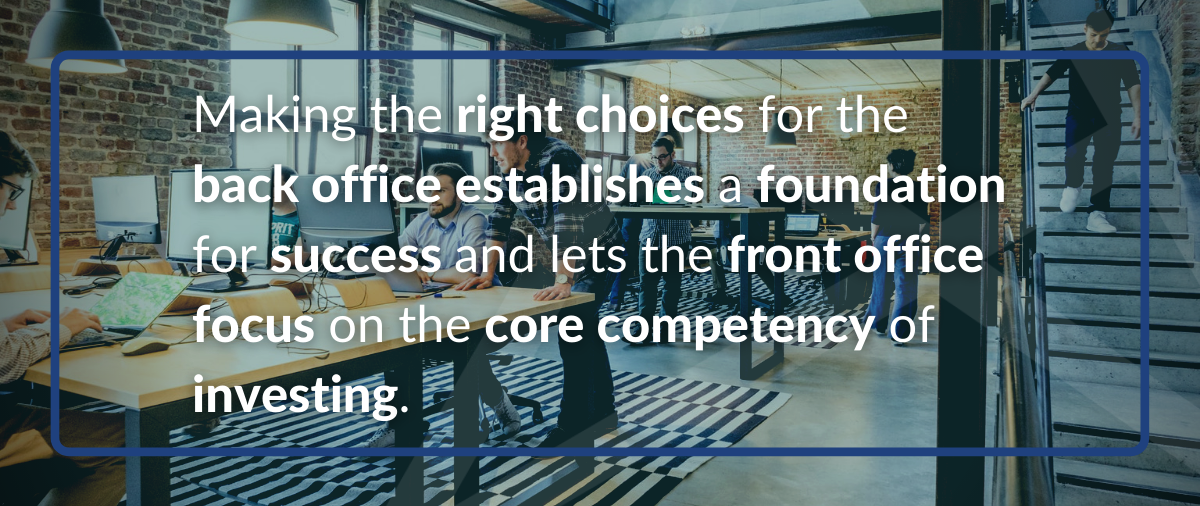Whether brokerage, banking, or investment management, the front office grabs all the glory. But it’s the back office that is the lifeblood of any firm, and problems there can torpedo client relationships, tarnish a firm’s reputation, and cost a lot of money. On the flip side, a back-office that hums with efficiency ensures seamless transactions and contented clients. With the right technology and processes in place, the back office is a silent, yet vital partner in mitigating the exposure to risk from trading breaks, delays in settlement, or data discrepancies. A strong back office allows firms to focus on developing investment theses, testing ideas, and establishing positions, rather than on clearing operational hurdles and mitigating risks.
Ensuring data integrity enhances post-trade processing
Many firms, unless newly established, often struggle with legacy systems that are not designed to work together seamlessly. In the dangerous crevasse between systems, a firm can easily come to grief. The lack of standardization among industry players can cause considerable pain. Take product referentials, for example. A trader on Bloomberg may use one symbol while the clearinghouse and clearing broker may have another designation for the security. Such data discrepancies have to be managed. Firms that include futures in their portfolios can experience particular challenges due to the nature of futures market data.
Fortunately, advances in post-trade processing software can help firms solve this problem. The key to standardizing data is the ability to recognize patterns. A post-trade software that maintains referentials or data dictionaries allows firms to use symbology in the quest for efficiency. With this standardization, processes like trade matching can continue unimpeded.
The Covid-19 pandemic demonstrated the importance of operational resiliency
Even before the pandemic, industry regulators had pointed to operational resiliency as on par with financial resilience in its importance to firms. But in March 2020, when the pandemic sent millions of office workers home to work remotely, employees in disparate physical locations were forced to ensure that back-office functions continued seamlessly. Manual processes were no longer effective, and firms needed to utilize cutting-edge technology to automate processes, ensure controls, and leverage human capital to review exceptions. Flexible, cloud-based systems ensure easier access for distributed teams, don’t require onsite maintenance, are scalable, and make it possible to enjoy the benefits of SaaS solutions in post-trade processing. Companies that embrace these technologies suffer fewer disruptions in the face of unforeseen events.
Innovative technology solutions cut costs and enhance profitability
Choosing the right back-office post-trade processing software can make a significant difference in the bottom line. Firms that depend on systems located on-premises need IT professionals who can maintain and update legacy systems. Cloud-based processing technology dispenses with the high cost of supporting these professionals and investing in, as well as maintaining, hardware. Moreover, a firm is no longer investing in capital equipment that appears on the balance sheet and is written down annually. Cloud-based services are income statement expenses and can offer tax savings as well.
Seamless back-office processing is crucial to client satisfaction
Every one of the features discussed makes a significant contribution to client satisfaction. Trade breaks and settlement issues can do more than just cost a firm money – they can cost clients’ money. Mistakes like these erode trust, damage reputation, and can cost a firm business. Fast and seamless settlement is an important component of client satisfaction.
Conclusion
It has never been more important to deploy efficient back-office solutions. Even when COVID-19 no longer compels us to work from home, many employees will still choose to work remotely. Distributed teams are now a fact of life and that will not change. Trading volumes are ever-increasing, volatility is likely to remain high, and more stringent regulatory oversight leaves no margin for inefficient processes. Firms can’t afford to spend energy and resources on operational errors in the back office. At the end of the day, it’s investment performance that counts. Making the right choices for the back office establishes a foundation for success and lets the front office focus on the core competency of investing.
___
About the Author
Rebecca Baldridge, CFA, is an investment professional and financial writer with more than 20 years of experience in creating content and research for asset managers, investment banks, brokers and other financial services clients. She’s worked for some of the biggest names in the industry, including Merrill Lynch Asset Management, JP Morgan Asset Management, BNY Mellon and Franklin Templeton. Rebecca also spent 9 years as an analyst and director of equity research in Moscow, working for several Russian banks. In late 2019, she founded Quartet Communications, a boutique communications firm serving financial services clients. Her writing has been published in outlets including Pensions & Investments, MSNBC.com, Inc. magazine, and Investopedia.com. She holds a B.A. in Russian from Purdue University and an M.S. in Finance from the Krannert Graduate School of Management at Purdue.
